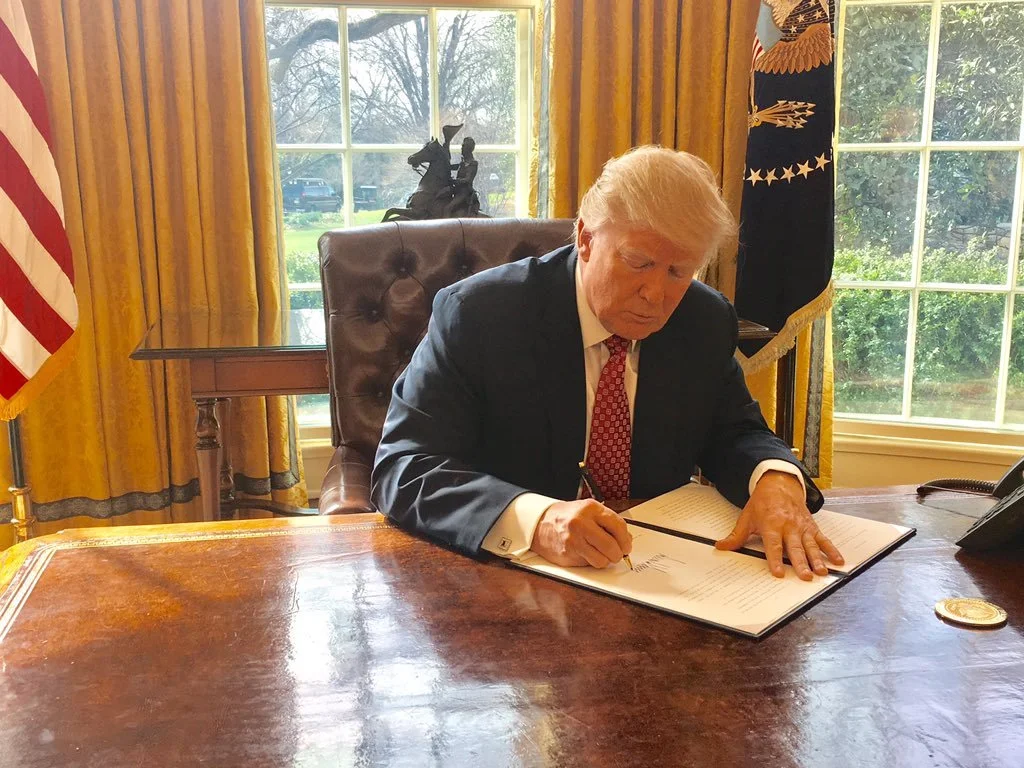10 Days of Trump Administration Executive Orders, Explained (Part 1/2)
Photo via Sean Spicer/Public domain/Wikimedia Commons
In his inaugural address, President Donald Trump promised to sign a “series of historic executive orders.” Over the course of the last 11 days, he did just that, signing a slew of executive orders targeting DEI, attacking birthright citizenship, overhauling Biden-era immigration policies and more.
This article is the first of two parts outlining the Executive Orders made by President Trump.
Immigration and national security
The president’s immigration agenda is largely laid out in the first of his immigration-related orders, an Executive Order titled “Securing Our Borders.” Among the provisions are plans to “[establish] a physical wall,” deploy immigration enforcement personnel and detain undocumented immigrants “apprehended for violations of immigration law.”
Executive Order 14159 — “Protecting the American People Against Invasion” — is one of a number of executive actions building on this agenda. The order revoked several Biden administration executive orders relating to immigration and instructed the Attorney General to “prioritize the prosecution of criminal offenses related to the unauthorized entry or continued unauthorized presence of aliens in the United States.” In addition, the order instructs the Attorney to withhold funds from “sanctuary” jurisdictions that attempt to refrain from carrying out deportations.
Trump also followed through with his promise to designate cartels as Foreign Terrorist Groups (FTOs) by signing Executive Order 14157. According to NPR’s Ryan Lucas, this designation would allow the government to prosecute not only the cartels themselves, but those who provide “material support” to the cartels as well. This could mean street gangs involved in drug trafficking in the U.S., U.S. companies doing business with Mexican companies potentially affiliated with cartels and migrants who pay smugglers to help them cross the border, Lucas said.
In addition, President Trump re-designated Ansar Allah, an Iran-backed Yemeni militant group also known as the Houthis, as an FTO.
In an Executive Order titled “Guaranteeing the States Protect Against Invasion,” the president called for the suspension of entries into the United States via the Southern Border “until I determine that the invasion has concluded.”
President Trump declared a national emergency at the border in an executive order that, along with invoking the National Emergencies Act, includes a provision that requires reports at the 30 and 90-day marks. The first report is to be submitted by the Secretary of Defense and “[outline] all actions taken to fulfill the requirements and objectives of [the] proclamation.” The second, a joint report by the Secretaries of Defense and Homeland Security, will recommend additional actions, such as whether to invoke the Insurrection Act of 1807.
The Insurrection Act, which authorizes the domestic deployment of troops under certain circumstances, could allow the president to use the military to enforce his immigration reforms.
Similarly, Executive Order 14163 suspends entry of refugees under the US Refugee Admissions Program, along with decisions on applications for refugee status, effective Jan. 27. Currently, an estimated 15,000 Afghan refugees are awaiting approval in Pakistan. Around 1,600 of these refugees have been approved, but have since had their travel plans canceled.
On Jan. 29, the president signed the Laken Riley Act into law. The bill, named for a Georgia nursing student killed by an undocumented Venezuelan immigrant, would require federal officials to detain all migrants charged with crimes.
That same day, Trump announced plans to detain “the worst criminal aliens threatening the American people” at Guantanamo Bay. The president followed his promise with an executive order directing the Secretaries of Defense and Homeland Security to expand the Migrant Operations Center at Guantanamo Bay to “provide additional detention space for high-priority criminal aliens.”
Perhaps among the most controversial of the new president’s actions, Executive Order 14160, titled “Protecting the Meaning and Value of American Citizenship,” asserts that “the Fourteenth Amendment has never been interpreted to extend citizenship universally to everyone born within the United States.”
Following this interpretation of the Fourteenth Amendment, the order excludes children born under either of two circumstances. This means children born to either a noncitizen father and a “mother [who] was unlawfully present … at the time of that person’s birth” or children born to a noncitizen father and a mother “whose presence… was lawful but temporary.”
In the wake of the Executive Order, the states of Washington, Illinois, Arizona and Oregon sought a temporary restraining order (TRO), which a federal judge in Seattle, Washington, granted on Jan. 23. The TRO will block enforcement of the order in the four states for 14 days, effective Jan. 23.
Trump also signed several Executive Orders addressing assorted foreign policy items.
Among the most recent of the president’s executive actions, an executive order titled "Additional Measures to Combat Anti-Semitism" instructs the heads of executive agencies to submit reports on “institutions of higher education alleging civil-rights violations related to or arising from post-Oct. 7, 2023, campus anti-Semitism.” In a fact sheet elaborating on the act, Trump promised to deport international students who participated in pro-Palestinian protests and revoke their student visas.
A White House statement released on Jan. 26 addressed the extension of Lebanon and Israel’s ceasefire agreement. The arrangement, which is monitored by the United States, will remain in effect until Feb. 18, 2025.
Finally, the president signed an Executive Order outlining his “Iron Dome for America” plan, which aims to advance the administration’s “peace through strength” defense policy.
Diversity, Equity, and Inclusion
Executive Order 14151, the first of several concerning diversity, equity and inclusion (DEI) called for the termination of “all discriminatory programs… mandates, policies, programs, preferences, and activities in the Federal Government, under whatever name they appear.”
That same day, the president once again attacked DEI, this time specifically targeting the Federal Aviation Administration. In a memorandum published on the White House website, the Trump administration accused the FAA of “[betraying] its mission by elevating dangerous discrimination over excellence.”
When a collision between a US Army Helicopter and an American Airlines passenger jet killed over 60 people in Washington, D.C., this week, Trump touted the executive order and appeared to blame the crash on DEI programs in place at the FAA.
The following day, in an Executive Order titled “Ending Illegal Discrimination and Restoring Merit-Based Opportunity,” Trump revoked five Executive Orders concerning DEI, most notably Lyndon B. Johnson’s Equal Employment Opportunity Executive Order of 1965.
Unlike Executive Order 14151, this order expands the anti-DEI mandate to the private sector, including affirmative action programs by government contractors and institutions of higher education.
In an executive order titled “Defending Women From Gender Ideology Extremism and Restoring Biological Truth to the Federal Government,” the Trump administration decried “gender ideology.”
“It is the policy of the United States to recognize two sexes, male and female,” the order declares.
The act goes on to define “male” as “belonging, at conception, to the sex that produces the small reproductive cell,” and “female” as “belonging, at conception, to the sex that produces the large reproductive cell.” It also requires that agencies exclusively use the term “sex,” rather than “gender,” when dealing in official capacities.
On Jan. 29, the president turned his attention to K-12 education, addressing what he described as the indoctrination of children using “radical, anti-American ideologies” in an executive order titled “Ending Radical Indoctrination in K-12 Schooling.”
The order instructs heads of the Departments of Education, Defense, Health and Human Services, and Justice to present the president with an “Ending Indoctrination Strategy” to be enforced against K-12 schools receiving federal funding. This strategy could ultimately empower the federal government to rescind funding from schools whose curriculums are found in violation of the order.
Some of these violations could include supporting a transgender student’s “social transition” or advancing “discriminatory equity ideology,” which is described as an ideology that “treats individuals as members of preferred or disfavored groups,”
Trump expanded on his K-12 education agenda with a second executive order the same day. This order calls on the Secretaries of Labor and Education to submit plans that would promote educational choice, allowing families to pursue “educational alternatives” such as private, faith-based, or charter schools using federal funding.
Finally, an Executive Order titled “Restoring Names that Honor American Greatness” outlined Trump’s plans to rename Mt. Denali and the Gulf of Mexico to Mt. McKinley and the Gulf of America, respectively.

